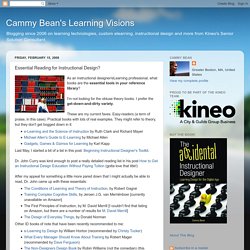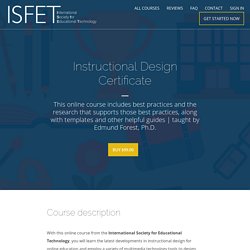

Becoming a Learning Experience Designer With Nyla Spooner. What Will Instructional Design Look Like in the Future? A sneak peek of the innovations and trends that will shape the next decade of instructional design.

As this decade comes to a close, instructional designers may find themselves reflecting on the trends that shaped the industry for the past ten years. Gamification, microlearning, and the shift to the cloud have dominated discussions both in the workplace and at industry conferences and events for the past several years, but as any designer knows, this field is one that constantly reinvents itself and pushes the limits of what’s possible. New buzzwords and trends constantly emerge, and our prediction is that the following concepts will define the next decade of instructional design.
Content Curation We have written about curation before, and this trend may likely become even more commonplace in the years to come. Data-Driven Design The concept of “big data” is dominating the conversation in many industries. Personalization of Learning Content Adaptation as a Pre-Requisite Design Skill. Essential Reading for Instructional Design? As an instructional designer/eLearning professional, what books are the essential tools in your reference library?

I'm not looking for the obtuse theory books. I prefer the get-down-and-dirty variety. These are my current faves. Easy-readers (a term of praise, in this case). Practical books with lots of real examples. Last May, I started a bit of a list in this post: Beginning Instructional Designer's Toolkit. Dr. After my appeal for something a little more pared down that I might actually be able to read, Dr. Other ID books of note that have been recently recommended to me:e-Learning by Design by William Horton (recommended by Christy Tucker)What Every Manager Should Know About Training by Robert Mager (recommended by Dave Ferguson)The Non-Designers Design Book by Robin Williams (not the comedian) (this was recently recommended to me by someone who asked the same question on LinkedIn.What would you add?
Photo credit: Little by MegElizabeth. Online Instructional Design Certificate (Online) When does the course start and finish?

This course is a completely self-paced online course - you decide when you start and when you finish. You can access the course site from your work computer, home computer, tablet, smart phone or any other device with an internet connection. The course site remembers your progress, so you can pickup right where you left off on any device. That means you can watch a few videos at work, then continue right where you left off on your home computer. How long do I have access to the course? Educational Technology - International Society for Educational Technology.
International Journal of Educational Technology. Call for reviewers The International Journal of Education (IJET) is looking for qualified referees to help review the increasing number of manuscript submissions we have been receiving.

IJET reviewers typically hold a terminal degree in educational technology, instructional design or another educational field of study and have a publication record in high-quality, peer-reviewed journals. IJET employs double-blind peer-review procedures and uses an online editorial management system to streamline the process. IJET publishes original research, literature reviews, implementation and evaluation studies, and theoretical, conceptual, and policy papers that contribute to our understanding of the promise and issues associated with the role of instructional design and technology in education. The journal covers all aspects of the design, development, and implementation of instructional processes and technologies aimed at increasing access, affordability, and outcomes for students. ADDIE Model - InstructionalDesign.org. The ADDIE model is the generic process traditionally used by instructional designers and training developers. The five phases—Analysis, Design, Development, Implementation, and Evaluation—represent a dynamic, flexible guideline for building effective training and performance support tools.
While perhaps the most common design model, there are a number of weaknesses to the ADDIE model which have led to a number of spin-offs or variations. It is an Instructional Systems Design (ISD) model. Most of the current instructional design models are spin-offs or variations of the ADDIE model; other models include the Dick & Carey and Kemp ISD models. One commonly accepted improvement to this model is the use of rapid prototyping. Instructional theories also play an important role in the design of instructional materials. In the ADDIE model, each step has an outcome that feeds into the subsequent step.
Analysis > Design > Development > Implementation > Evaluation Analysis Phase. Scenario example: Practice the handoff conversation – Cathy Moore – Training design.